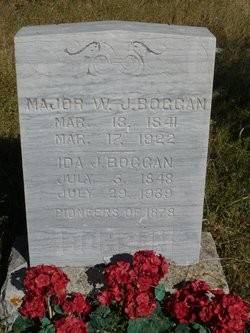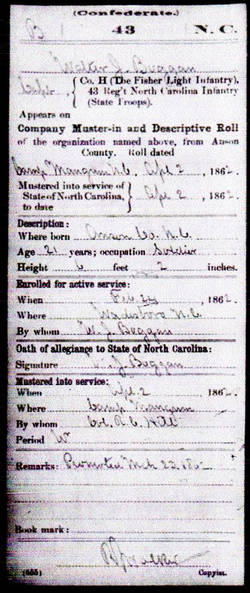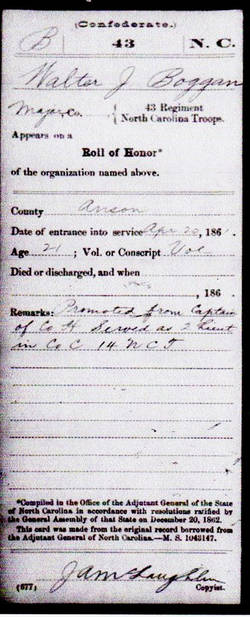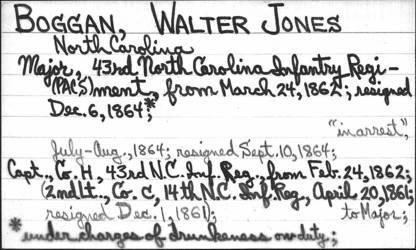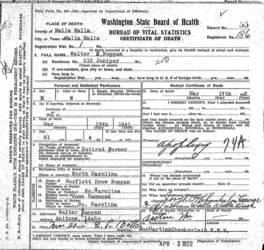Walter Jones Boggan
Representing: Confederate
Unit History
- 43rd North Carolina 43rd NC Light Infantry aka 43rd NC Infantry State Troopers H & B
Full Unit History
4th INFANTRY VOLUNTEERS
Organized: 6/6/1861 Greensboro, NC
Mustered In: Inf. Not Avail.
Designation Changed: 11/14/1861
14th NORTH CAROLINA VOLUNTEER INFANTRY
Designation Assigned: 11/14/1861
Surrendered/Mustered Out: 4/9/1865 Appomattox Court House, VA
43rd NORTH CAROLINA VOLUNTEER INFANTRY
Organized: 3/1862 Camp Mangum Raleigh, NC
Mustered In: 4/24/1862 (est.) Camp Mangum Raleigh, NC
Surrendered/Mustered Out: 4/9/1865 Appomattox Ct. House, VA
Regimental History
REGIMENTAL HISTORY: (4th/14th)
This unit was initially organized as the 4th Infantry Volunteers, a twelve month "state" regiment. It was re-designated the 14th on 11/24/1861 when North Carolina consolidated their state and volunteer troops.
On 4/27/1862 the 14th was re-organized when it was placed under the auspices of the Confederate States of America (CSA) to serve for three years or the duration of The War. Its period of service was within the eastern theater of the American Civil War (ACW).
As originally fielded, men in the unit's ten companies were principally recruited as follows: "A" (The Roanoke Minute men) Warren and Halifax counties; "B" (Thomasville Rifles) Davidson County; "C" (Anson Guard) Anson County; "D" (Cleveland Blues) Cleveland County; "E" (Oak City Guard) Wake County; "F" (Rough and Ready Guards) Buncombe County; "G" (Reid Guard) Rockingham County; "H" (Stanly Marksmen) Stanly County; "I"(Lexington Wild Cats) Davidson County and "K" Wake County.
Virginia actions of 1862 included: April siege of Yorktown, Lee's Mill (4/5), Williamsburg (5/5), Seven Pines (5/31 - 6/1), Gaines Mill (6/27) and Malvern Hill (7/1). Moving to Maryland the 14th fought at South Mountain/Crampton's Gap (9/14) and Sharpsburg/Antietam (9/17). The combat year was concluded at Fredericksburg, VA (12/13).
1863 found the 14th at Chancellorsville (5/1 - 4) and Martinsburg (6/14), VA. The regiment then moved to Gettysburg, PA (7/1 - 3). At the latter place it suffered twenty per cent (20%) casualties including three hundred (300) on the field. Returning southward to Virginia the unit saw action at Warrenton Springs (10/12, the Bristoe Campaign (Oct. - Nov.), Kelly’s Ford (11/7) and during the Mine Run movements (11/7 – 12/21).
1864. Virginia clashes with the enemy during the final, full year of The War encompassed the Wilderness (5/5 - 6) Spotsylvania Court House (5/8 - 21), North Anna (5/22 - 26) and Cold Harbor (6/1 - 3) during Union Gen. U.S. Grant's Overland Campaign. June actions in the Shenandoah Valley preceded Confed. Gen. Jubal A. Early's movements northward toward Washington City. During this period the 14th was active at Monocacy, MD (7/9) before returning to the Shenandoah Valley where it saw combat at Third Winchester (9/19), Fisher's Hill (9/22) and Cedar Creek (10/19).
Final conflicts during the opening months of 1865 included Saylor's/Sailer's Creek (4/6) and Appomattox Court House (4/9) in Virginia. At the latter place, the 14th surrendered (4/9) with Confed. Gen. Robert E. Lee's Army Of Northern Virginia.
REGIMENTAL LOSSES:
Although total loss numbers are not available, on 4/9/1865 the regiment surrendered only seven (7) officers and one hundred seven (107) enlisted men.
REGIMENTAL HISTORY: (43rd)
The 43rd, a three year/duration of The War infantry regiment, was organized in 3/1862 under the auspices of the Confederate States of America (CSA). During its period of existence it served in both the western and eastern theaters of the American Civil War (ACW).
As initially fielded, companies of the 43rd were recruited, primarily, as follows: Co. "A" Duplin County; Co. "B" Mecklenburg County; Co. "C" Wilson County; Co. "D" Halifax and Cumberland County; Co. "E" Edgecombe County; Co. "F" Halifax County; Co. "G" Warren County; Co. "H" (The Fisher Infantry) Anson County; Co. "I" Anson County and Co. "K" Anson County.
The 43rd was initially ordered to Wilmington, NC. Then, in May, 1862 it was moved into Virginia. There, it remained out of harm's way for the balance of the year.
June and July, 1862 found the 43rd active on the Virginia peninsula during the Seven Days Battles (6/25 - 30) and the closing engagement at Malvern Hill (7/1). The remainder of the year was relatively quiet as far as the 43rd was concerned.
In mid, 1863 the 43rd found itself with Confed. Gen. Robert E. Lee's forces as they marched northward out of Virginia into Maryland and, ultimately, Gettysburg, PA. With the Rebel loss at the latter place, Confederate troops, including the 43rd limped back into Virginia. There, the Mine Run Campaign (11/7 - 12/2) concluded the calendar and combat year.
During the spring of 1864 the 43rd was ordered to Bermuda Hundred as part of the defenses of Richmond, VA. From there, it moved into the Shenandoah Valley before marching with Confed. Gen. Jubal Early on the defenses of Washington, D.C. This movement placed the 43rd at the battle of Monocacy, MD (7/9/1864). After that it returned to the Shenandoah Valley until the forces in gray were kicked out of that region late in the year. The 43rd then occupied the trenches around Petersburg, VA.
1865. With the breaching of the Rebel entrenchment lines at Petersburg on 4/2 Robert E. Lee's Army of Northern Virginia began retreating westward. That movement came to an end at Appomattox Court House, VA. With Lee's (4/9) surrender at that place the days of the 43rd were ended.
REGIMENTAL LOSSES:
Loss Numbers Not Available
Soldier History
SOLDIER: (4th /14th)
Residence: Wadesboro Anson County, NC Age: 20.1 yrs.
Enlisted/Enrolled: 4/22/1861 Rank: 2nd Lieut.
Mustered In Commissioned: 4/22/1861
Resigned: 12/1/1861
Mustered Out: 12/1/1861
Highest Rank: 2nd Lieut.
Rank At Resignation: 2nd Lieut
SOLDIER: (43rd)
Residence: Wadesboro, NC Age: 20. 11 yrs.
Mustered In/Commissioned: 2/24/1862 Camp Mangum Raleigh, NC Rank: Capt.
Resigned: 3/23/1862 to accept promotion to Major.
Mustered In/Commissioned: 3/24/1862
Resigned: 12/6/1864 (Maj.)
Highest Rank: Maj.
Rank At Resignation: Maj.
Family History
WALTER J. BOGGAN
4th INFANTRY VOLUNTEERS Co. "C"
14th NORTH CAROLINA INFANTRY Co. "C"
43rd NORTH CAROLINA INFANTRY Co. "H" and "Field & Staff"
PERSONAL/FAMILY HISTORY:
Walter Jones Boggan was born 3/13/1841. The location of his birth was Anson County, NC. Further, although it is not documented, likely he was born in - or near- the community of Wadesboro as that was the Boggan family address at the time of the 1850 and 1860 U.S. Census tallies.
Parents of Walter were Norfleet Drew Boggan (b. 11/29/1805 loc. unk. - d. 11/8/1854 Anson County, NC) and Jane Gould (nee Hammond b. 7/9/1813 loc. unk. - d. 3/6/1858 Anson County, NC) Boggan. The Boggans were a farm family, but Norfleet, in addition to tilling the soil, also had enough education to serve as a clerk in the local court system.
Norfleet and Jane produced at least six children. Of the six, Walter was third-born. Older than he were Rosa E. Boggan (b. 6/8/1835 Anson County, NC - d. 1857 Anson County, NC) and Harriet Eleanor Boggan (b. 5/20/1837 Anson County, NC - d. 1862 Anson County, NC). Younger than Walter were: William H. Boggan* (b. 6/15/1843 Anson County, NC), James N. Boggan** (b. 1846 Anson County, NC) and Lydia Jane Boggan (b. 12/12/1847 Anson County, NC).
Both of Walter's parents died in the mid to late 1850s. As such, by the time of the 1860 U.S. being the family head had fallen upon the shoulders of daughter Harriett and, by then she, too, was a widow...................
It appears that Walter remained with his birth family until civil war broke out in America during April, 1861. At that time the six foot two inch (6’ 2”) tall man, who noted his occupation at the time as "merchant,” enlisted and was mustered/commissioned into the 4th/14th North Carolina Infantry.
Rather than militarily starting out as a private soldier, Walter entered the 4th/14th as a commissioned second (2nd) lieutenant. He maintained this position until 12/1/1861 when he appears to have resigned his commission in order to accept the higher rank of Captain with the Confederate States Army (CSA). It seems he assumed the rank captain on 2/24/1862 within the 43rd North Carolina Infantry.
It seems Walter was a captain only a short period of time. He reportedly resigned that rank in order to accept promotion to the rank of major within the 43rd North Carolina Infantry. *** Although this transition was made, the new rank did not sit well with Major Boggan.
In spite of the relative ease which Walter accepted and moved through the CSA military ranks, his periods of service were not without travails. A common thread that runs through his period of military service is illness - rather serious illness, at that.
It appears that sometime during 1863 and into '64 our major was dealing with chronic dysentery. This condition may have been the cause of his entering a military hospital in Richmond, VA as early as 7/31/1863. By then end of that calendar year he was home on furlough because of bleeding hemorrhoids.
The furlough does not seem to help much as; by 1/5/1864 Major Boggan was back in Richmond Hospital #4. It may have been such recurring medical issues that moved him to drinking. By mid-1864 he was "in arrest" on a charge of being drunk on duty. In 12/1864 Major Walter Boggan resigned his commission and left the service of the CSA.
With his somewhat ignominious military life behind him, Walter returned to civilian life. Where that civilian life was, initially, however, we do not know. He is next heard from in the U.S. Census of 1870.
By 1870 Walter was residing in Richland Washington County, AR. There, his occupation was noted as teacher. **** Also he was married and a father.
First, the marriage. Mrs. Walter Boggan was Ida J. Enyart. Ida had been born 7/5/1848 in Washington County, AR. How, when and where the two had met are unknowns. Another unknown is when and where the two wed. It can be surmised, however that the wedding was in Arkansas ca. 1868.
Now, fatherhood. Walter and Ida's first child, son Walter Carroll Boggan, was born 2/22/1869 in Washington County, AR. There were more children to come!!
At the dawn of the twentieth century Ida Boggan would tell census officials that she had birthed three children. Two of those three were then living. Aside from Walter Carroll, the other identified child born to Walter and Ida was John Norfleet Boggan. John N was birthed 10/24/1883 in Fayette County, KY. However, according to U.S. of census 1880 the Boggan family was, by then, in Columbia County, Washington Territory (WT). Why, then the son was born in Kentucky is not known.
As noted, by 1880 Walter and his family had quitted Arkansas and were farming in Washington Territory's (WT) Asotin County. What had drawn the North Carolinians from Arkansas to this far southeast corner of the Pacific Northwest’s WT is not documented. Likely, however, it was the availability of fresh farming land as, by 1885. Walter – who, by then, been joined by Brother William - both noted themselves as farmers.
Encapsulating a bit, in 1885 Walter and Ida's community residence had been noted only as Asotin County, WT By 1900, and the dawn of the twentieth (20th) century it was more clearly delineated as the Grande Ronde (River) area of Asotin County. As of 1910 it was denoted as Anatone, Asotin County while, in 1920 it was - once more Grand Ronde.
Major Walter Jones Boggan died on 3/17/1922 in Asotin County, WA. At passing he had just turned eighty one (81) years of age. Burial was/is in Asotin County's Anatone Cemetery.
And Ida? Following Walter's passing she remained in eastern Washington. In 1935 she was residing in Walla Walla, Walla Walla County, WA. With whom she may have been living at the time is not documented.
Ida died on 1/29/1939 in Anatone Asotine County, WA. She was/is buried with Walter in the Anatone Cemetery.
____________________________________________________________________________________________________
* During the ACW William served with the 4th/14th North Carolina Infantry. He survived The War. He is buried in Asotin County, WA’s Anatone Cemetery.
** During the ACW James served in the 2nd and 3rd North Carolina Light Artillery. He survived The War and moved westward to join brothers Walter and William. He is buried in Asotin County, WA’s Asotine City Cemetery.
***Available records are unclear on the matter of whether Walter's entrance into the ranks of the 43rd was entirely his option or if he was a member of the Provisional Army of the Confederate States (PACS). PACS was an "umbrella" organization that functioned to provide commissioned officers to various CSA military units based on where, individually, they might be needed.
****Also, in Walter's home at that time was his brother, William. William, too, was employed as a teacher.
POSTED: 6/14/2023
UPDATED:
Cemetery
Buried at Anatone Cemetery
